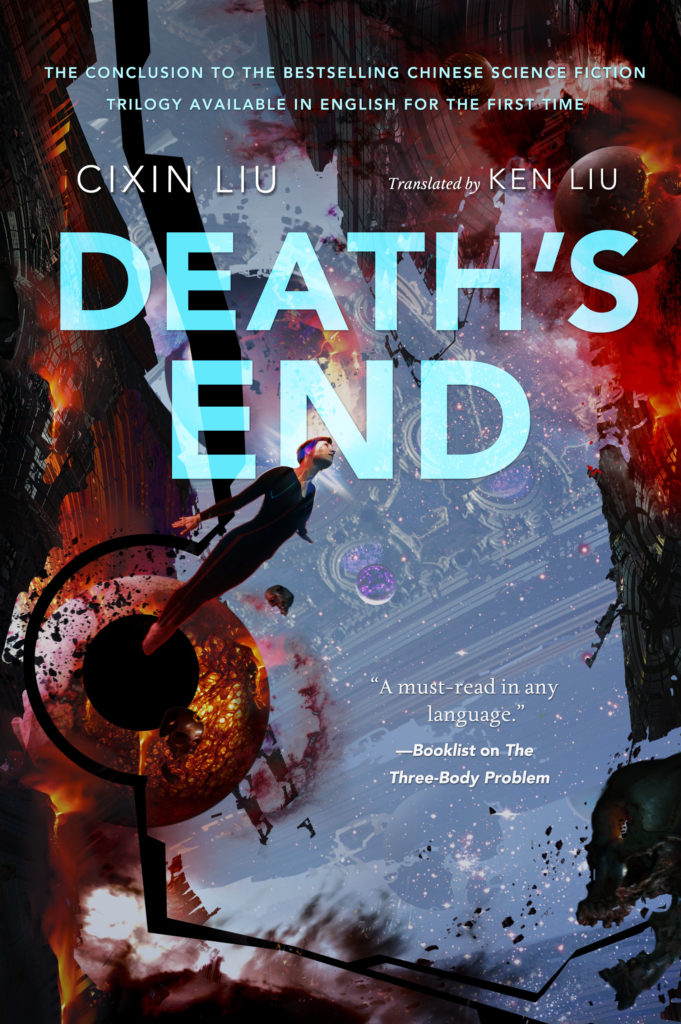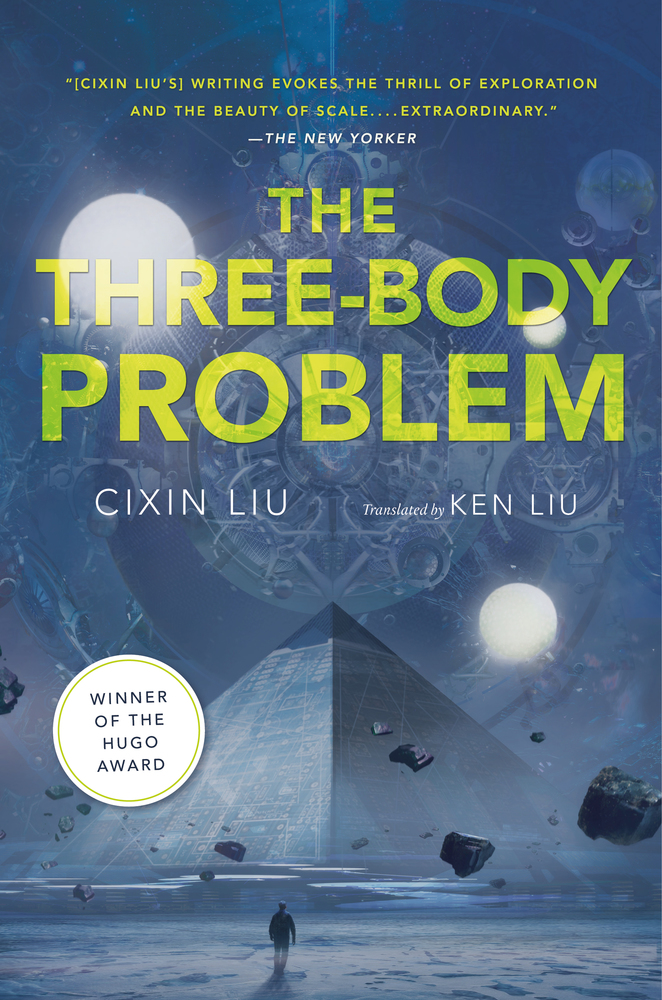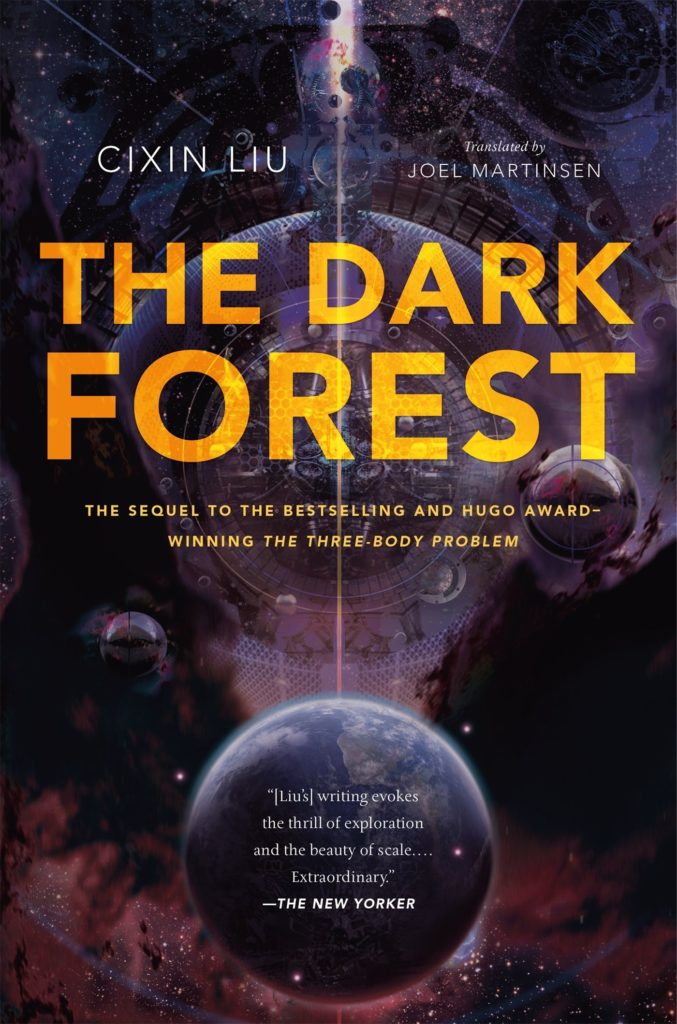Death’s End (2016)
Written by: Cixin Liu
Translated by: Ken Liu
Genre: Science Fiction
Pages: 608 (Hardcover)
Series: Remembrance of Earth’s Past Book 3
Publisher: Tor
Why I Picked It: I had already read The Three-Body Problem (#1) and was halfway through The Dark Forest (#2) when I was given the opportunity to review Death’s End. I am notorious for starting series and not finishing them (I bought the first two books of The Expanse series at ChiCon and despite absolutely loving the first entry, I haven’t gone on to read the others). So I figured a review would give me incentive to plow through The Dark Forest and plunge right into the concluding book. Despite being more of a “science fiction” reader than a “science” reader (although please throw more Gregory Benford and Kathleen Ann Goonan at me), I was intrigued by The Three-Body Problem, and at MidAmericonII last August, everyone hummed with awed praise for Death’s End. In addition, because I’m making an effort to read more writers of color and writers from around the world, I was definitely interested in finishing the series.
Also, I am a total, unabashed sucker for Stephan Martiniere covers. I had the pleasure of meeting Mr. Martiniere at the 2004 San Diego Comic Con, and in addition to creating fantastic backdrops and awesome (in the literal sense of the word) artwork, he was just the nicest guy. There could not have been a better fit between artist and concept for Cixin Liu’s trilogy. However, I digress.
The premise:
The New York Times bestselling conclusion to a tour de force near-future adventure trilogy from China’s bestselling and beloved science fiction writer.
With The Three-Body Problem, English-speaking readers got their first chance to experience the multiple-award-winning and bestselling Three-Body Trilogy by China’s most beloved science fiction author, Cixin Liu.
Three-Body was released to great acclaim including coverage in The New York Times and The Wall Street Journal. It was also named a finalist for the Nebula Award, making it the first translated novel to be nominated for a major SF award since Italo Calvino’s Invisible Cities in 1976.
Now this epic trilogy concludes with the New York Times bestelling Death’s End. Half a century after the Doomsday Battle, the uneasy balance of Dark Forest Deterrence keeps the Trisolaran invaders at bay. Earth enjoys unprecedented prosperity due to the infusion of Trisolaran knowledge. With human science advancing daily and the Trisolarans adopting Earth culture, it seems that the two civilizations will soon be able to co-exist peacefully as equals without the terrible threat of mutually assured annihilation. But the peace has also made humanity complacent.
Cheng Xin, an aerospace engineer from the early 21st century, awakens from hibernation in this new age. She brings with her knowledge of a long-forgotten program dating from the beginning of the Trisolar Crisis, and her very presence may upset the delicate balance between two worlds. Will humanity reach for the stars or die in its cradle?
There will be spoilers for the first two books in the trilogy, and some discussion of the plot twists in Book #3, but I will try my best not to spoil it. Chic’s honor.
Discussion: There are some things I can’t give away, because this is one trilogy people will want the pleasure of reading, just to appreciate its scope. Said scope, however, is the main reason I have to catch everyone up on the first two books because it is epic, and Death’s End is even more epic. And if you’re not familiar with certain philosophic, scientific and mathematical concepts beforehand, you will have at least a passing familiarity with them afterward.
 In The Three-Body Problem, scientist Ye Wenjie, disillusioned with humanity’s destruction of the earth, contacts the hostile Trisolarans, an alien civilization whose planet is dying. The Trisolarans turn their attention to Earth and announce their fleet will arrive in 400 years to exterminate humanity and take the planet. The Trisolarans have two advantages: the Earth-Trisolaris Organization, a group of humans led by Ye Wenjie who want to advance the Trisolaran takeover, and dimensional supercomputers called sophons, which the Trisolarans deployed both to block the laws of physics on Earth — stopping human scientific progress that might be used to defeat the Trisolarans — and allow the Trisolarans to spy on any human efforts to repel their fleet.
In The Three-Body Problem, scientist Ye Wenjie, disillusioned with humanity’s destruction of the earth, contacts the hostile Trisolarans, an alien civilization whose planet is dying. The Trisolarans turn their attention to Earth and announce their fleet will arrive in 400 years to exterminate humanity and take the planet. The Trisolarans have two advantages: the Earth-Trisolaris Organization, a group of humans led by Ye Wenjie who want to advance the Trisolaran takeover, and dimensional supercomputers called sophons, which the Trisolarans deployed both to block the laws of physics on Earth — stopping human scientific progress that might be used to defeat the Trisolarans — and allow the Trisolarans to spy on any human efforts to repel their fleet.
The second book, The Dark Forest, is concerned with deterrence theory. Think of the Cold War on an interstellar scale. Because the human mind is the only place the Trisolarans can’t see, the UN designates four men as Wallfacers — each will design plans to halt the Trisolarans, and make these plans known to no one else. (Talk about a gamble.) The Trisolarans respond by dedicating four Wallbreakers. Each assigned to a Wallfacer, they will discover the plans and/or annihilate their respective targets. Three Wallfacers are exposed and destroyed (one Wallbreaker was a Wallfacer’s wife!); the fourth, the hedonistic, Jonah-like Luo Ji, who spends a lot of time running away from his responsibilities, eventually devises a theory based on deterrence. In testing it, he essentially destroys a planet — Luo Ji discovered a third alien civilization, broadcast the whereabouts of its homeworld, and a fourth alien civilization destroyed it. Therefore Luo Ji is able to rebuff the Trisolaran invaders: if they invade, he will broadcast the location of both the Trisolaran homeworld and Earth into the universe. The Trisolarans capitulate; they agree to lift the sophons and share their technology with Earth.
Those are the integral plots of each, in teeny, tiny nutshells. And these lead us to the third book: Death’s End.
To move forward, we need to introduce several concepts: Fermi’s Paradox, “dark forest” theory, and deterrence via mutually assured destruction, because the entire Three Body series is an exploration of these concepts.
Fermi’s Paradox, named after physicist Enrico Fermi, calls attention to the mathematically high probability that other civilizations exist in the universe despite the low actual evidence we have for it. Given the existence of these civilizations, how do we account for our galactic loneliness? The SETI institute does a good job of explaining; start here and click forward at the end of each page.
 This leads us to dark forest theory, the particular answer to the Fermi Paradox explored by Cixin Liu. As Luo Ji explains in The Dark Forest, assuming the universe is full of life, and if the goal of any life is to survive in a universe where there is competition for finite resources, one civilization can never be sure of the true intentions of other civilizations, so it is to everyone’s advantage not to reveal themselves. In essence, we are all hiding in a “dark forest.” In addition, the extraordinary distance between star systems leaves a lot of time to build up mistrust. To explore this concept further, start here.
This leads us to dark forest theory, the particular answer to the Fermi Paradox explored by Cixin Liu. As Luo Ji explains in The Dark Forest, assuming the universe is full of life, and if the goal of any life is to survive in a universe where there is competition for finite resources, one civilization can never be sure of the true intentions of other civilizations, so it is to everyone’s advantage not to reveal themselves. In essence, we are all hiding in a “dark forest.” In addition, the extraordinary distance between star systems leaves a lot of time to build up mistrust. To explore this concept further, start here.
Lastly, let’s talk about deterrence and mutually assured destruction, which may be familiar to those of us who lived through or studied the Cold War. Deterrence as a military strategy is the act of preventing war by dissuading a government/state from doing something we don’t want them to do, whether that is a direct action or colluding with another government. Intimidation is key; an adversary has to believe that the first government has the ability to follow through on its threat. “If you do x, I will do y, and I have the power to make it happen.”
Luo Ji’s extermination of a faraway planet, and subsequent threat to the Trisolarans, is deterrence according to mutually assured destruction. If the Trisolarans attack Earth, he will broadcast the location of both systems to civilizations hiding in the dark forest of the universe. Trisolaris will be destroyed, and if its fleet remains in Earth orbit, it will be destroyed when that alien civilization turns its attention to Earth. Remember that Star Trek: Voyager episode 4.7, “Scientific Method,” which ends with Captain Janeway aiming Voyager between binary stars in order to force invisible alien experimenters off the ship? If they don’t leave, everyone — aliens and crew — will die if the gravitational forces rips the ship apart. That’s mutually assured destruction.
This is all very simplistic, and there are plenty of people out there who can catch my mistakes and/or elaborate on these concepts. (Please do.)
So, if you haven’t read it, you can imagine that Liu Cixin’s trilogy is very complex. Moral dilemmas and mathematical and philosophical puzzles abound against an epic backdrop that spans millennia.
It’s also very imaginative. First-contact stories are as old as, well, the stars. And most of us could probably name at least three first-contact stories that don’t end well (Invasion of the Body Snatchers comes to mind). But Liu freshens it up in a complex and mostly engaging manner. I say mostly engaging, because he does tend to talk at length about scientific and philosophical quandaries, and a lot of it goes over my head. However, what shines through in the prose is Liu’s excitement at imparting all of this knowledge, which makes me excited because he’s excited. As a bonus, he doesn’t make me work for it; he (sometimes eventually) explains the impacts of the knowledge he introduces.
So in that sense, Death’s End (and the trilogy) is a nice, tidy package. The reader gets a lot of information thrown at them, but the refreshing take makes it more fascinating than it otherwise would be. Simultaneously, for as complex as The Three-Body Problem and The Dark Forest are, Death’s End is infinitely more expansive. Death’s End capitalizes on and magnifies that complexity.
Yet the story is not difficult to follow. This is mostly due to the gift/plot device of hibernation, or suspended animation, which allows the reader to engage with a centuries-long story via several major characters. Liu weaves them together in three different stories, in a non-linear narrative peppered with “excerpts” from a history written post-story (a la Jack McDevitt). These serve to move the action and the story forward by leaps and bounds; otherwise Death’s End might’ve actually ended up being a thousand pages or more.
Our character anchor is Cheng Xin, a scientist and creator of the Staircase Project, a space probe meant to reach an invasion fleet of Trisolaran ships. Cheng Xin, along with her business partner AA (pronounced Ai Ai), uses hibernation to stay alive for centuries, and it is through her viewpoint that the story chronicles what happens to Earth throughout these eras. Cheng Xin is unable to continue Luo Ji’s policy of deterrence via mutually assured destruction, and the Trisolarans attack Earth, enforcing human resettlement to Australia and then influencing the human population to diminish itself via (offscreen) cannibalism. (When the Trisolarans made this announcement, not even three hundred pages in, I read on in utter disbelief: “Cixin Liu went there.”) Later, Earth’s population must escape to the stars; humanity then inhabits several space cities orbiting in the shadows of the solar system’s gas giants. It is Cheng Xin who will decide the ultimate fate of the entire universe, and all her experiences, failures, and theories bring her to that decision.
The second storyline follows the crew of the starships Blue Space and Gravity. One ship was sent to retrieve the other and bring its crew back for trial; after the Trisolarans attack Earth, Gravity does what Cheng Xin could not and broadcasts the coordinates to Earth and Trisolaris to the rest of the universe. The Trisolaran home system is destroyed, after which the starships combine crews to return home — but not before discovering four-dimensional space and a damning secret about the universe that will decide Earth’s, and every civilization’s, ultimate fate.
In the third storyline, the Trisolaran fleet retreats from Earth, but not before reuniting Cheng Xin with Yun Tianming. Yun Tianming was introduced as a dying scientist who adored Cheng Xin so much that in the first stages of the Trisolaran Crisis, he bought Cheng Xin a star, and who, after being revived by and living with the Trisolarans, is able to convey information, through the use of coded fairy tales, to Cheng Xin about Trisolaran technology and what has been discovered about the universe.
In a science fiction or fantasy novel, the setting is always a kind of character, but Liu really brings out the universe and makes it its own character. What happens with the universe affects the people in it, and what the people do in the universe affects the universe.
To say much more about the plot would ruin the books. Suffice to say, the remnants of the Trisolarans and the remnants of Earth, whose people were once bitter adversaries, form a kind of alliance; when Cheng Xin and her companion Guan Yifan are the only two people left, the Trisolarans care for them.
I struggled writing this review because Death’s End is so staggering that I wanted to share everything about it, but if I do that, maybe none of you will ever read it. Which would be a complete and utter shame. Also, although I find myself wanting to talk about the book just to make sure I can wrap my head around all of its concepts, I’m just not scientific enough to adequately explain all of the moral dilemmas and scientific concepts Cixin Liu dispatches in this trilogy. Yes, his writing can be heavy-handed at times, but Cixin already did all the work, and I should let him talk.
In conclusion: Death’s End, and consequently The Three Body trilogy, is probably the most ambitious science fiction stories I’ve ever read, and it delivers on that ambition by successfully concluding the trilogy and outdoing it, all at the same time. That can’t possibly be easy to pull off, but Cixin Liu does it. There were points in the story where I wondered if he was going to throw in anything else. Space elevators, space cities, lightspeed ships, mini-universes… Holy crap.
If anything, people should read this trilogy for its imagination, scope, and uniqueness. This trilogy, and its creator, have sometimes been panned for being cynical. Certainly Liu’s views on first contact, at least in these books, smacks of cynicism. I tend to think those reviewers missed the point. How we reach out to the universe is a valid concern, one which is also shared by a few scientists (Stephen Hawking, Neil DeGrasse Tyson, and a host of other colleagues). But Liu’s trilogy, and Death’s End in particular, is also hopeful. Liu himself wishes to be hopeful. This is in the postscript to The Three-Body Problem:
Let’s turn the kindness we show toward the stars to members of the human race on Earth and build up the trust and understanding between the different peoples and civilizations that make up humanity. But for the universe outside the solar system, we should be ever vigilant, and be ready to attribute the worst of intentions to any Others that might exist in space. For a fragile civilization like ours, this is without a doubt the most responsible path.
Liu’s trilogy is a paean to scientific discovery, creativity, human moral complexity, and ultimately the human race itself. Science is described and used in a way that it would actually take place, and not used as a plot device. The result is that I have come away from this series feeling I’ve read something “real.” It is not for me to tell prospective readers the end of the story. (As much as I love the other entries in the Hugo for Best Novel category, I do think it should win, hands down.) But, given the book’s scale, and its ambition, which again is far more expansive than its predecessors, once you finish Death’s End, you may never look at the universe the same way again. I can’t.
“In the eternal night of the Orion Arm of the Milky Way Galaxy, two civilizations had swept through like two shooting stars, and the universe had remembered their light.”
— Cixin Liu, Death’s End, (pg. 593)

Yeah, I really enjoyed Three-Body Problem, but got bogged down in The Dark Forest. I wondered if it was a problem with the translator, which was different than the first book. Reading this post has got me wanting to go back and pick this trilogy back up though: I’ve got all three books.
And I’m with you on Stephen Martiniere. I adore his covers!